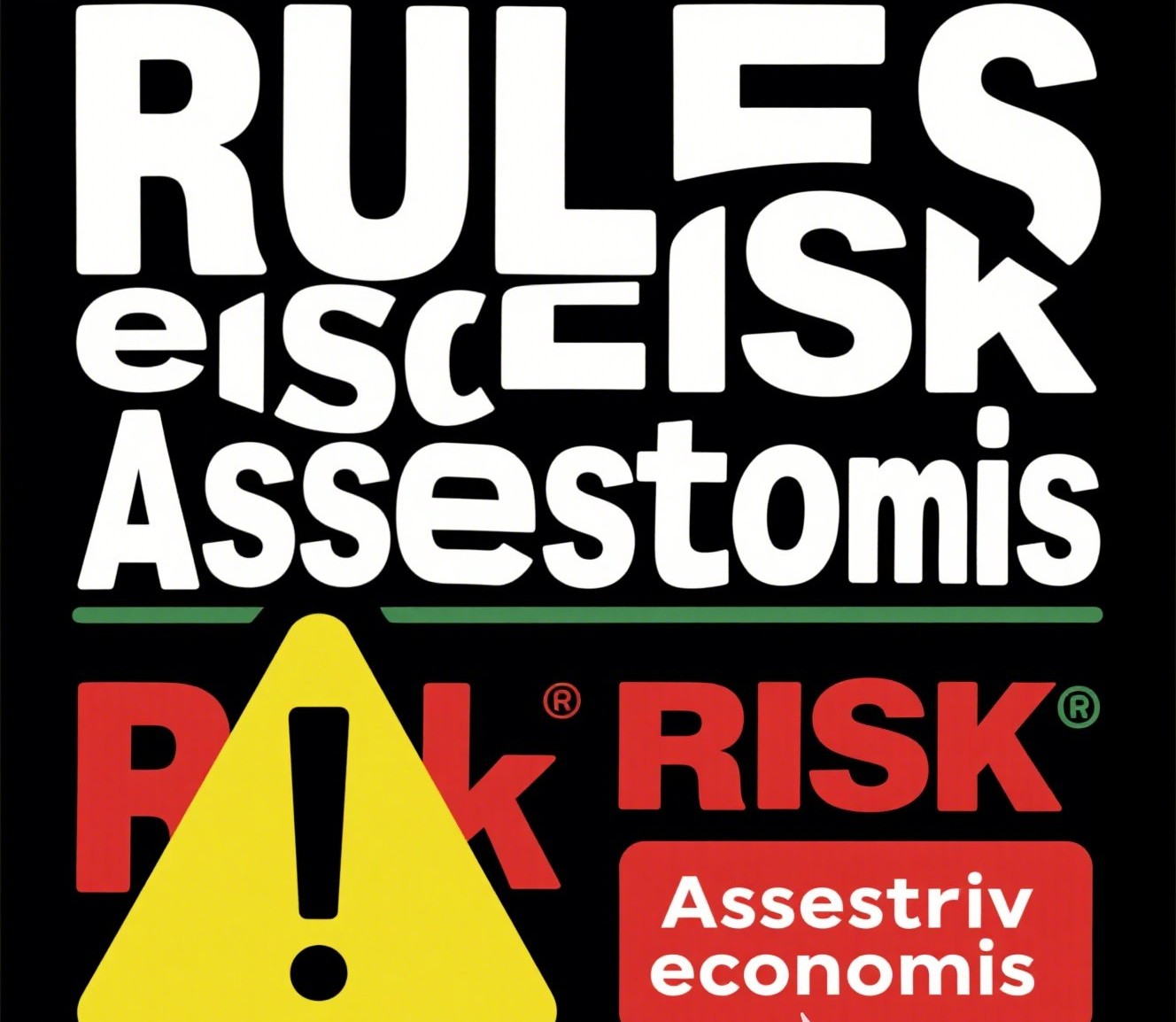rules of risk assessment economics is crucial for businesses. It helps them navigate uncertainties and make informed decisions.
Examining prospective financial hazards and their impact on society is known as risk estimation economics. It combines economics and risk management principles to help organizations predict and mitigate losses. This discipline is vital for businesses of all sizes, as it aids in identifying threats and planning strategies to address them.
Understanding the core rules can enhance companies’ decision-making processes and safeguard their assets. This blog post will explore the key rules of risk assessment economics, providing insights to better manage risks and protect your business’s future.

Table of Contents
Importance Of rules of risk assessment economics
Risk evaluation is essential in any type of company or economic activity. It ensures that judgments are well-informed by helping to understand possible dangers and opportunities. Gaining insight into the significance of risk evaluation helps improve growth and control.
Let’s explore this in detail.
Economic Impact
Risk assessment plays a significant role in the economy. It helps businesses and governments understand the potential financial impact of various risks. Early identification of risks allows for the creation of mitigation options, leading to more stable economic growth.
Consider the following benefits:
- Cost Savings: Identifying risks early can save significant costs by preventing potential losses.
- Resource Allocation: Helps in better allocation of resources by focusing on high-risk areas.
- Investor Confidence: Regular risk assessments increase investor confidence as proactive measures are taken.
Here is a table that shows the potential economic impacts of risk assessment:
Aspect Impact
Cost Management Reduced unexpected costs
Investment Increased investor confidence
Resource Allocation Efficient use of resources
Risk assessment helps maintain economic stability. It ensures that potential financial pitfalls are addressed and strategic planning benefits from an improved economic environment.
Decision Making
Risk assessment is vital for making informed decisions. It provides a clear picture of potential risks and their impacts, which is crucial for decision-makers. Then, they can balance the advantages against the drawbacks before selecting.
The following points highlight their importance:
- Generating Informed Decisions: Those making decisions are informed about potential threats.
- Strategy Preparation: Assists in formulating plans that take possible risks into view.
- Flexibility: Allows flexible decision-making, adapting to new information as it becomes available.
Here is an ordered list showing the steps in decision-making with risk assessment:
- Identify potential risks.
- Analyze the impact of these risks.
- Develop strategies to mitigate risks.
- Implement decisions based on analysis.
- Monitor and revise strategies as needed.
Risk assessment ensures that decisions are not made in a vacuum. It provides an in-depth knowledge of the possible outcomes, resulting in more robust and flexible decision-making procedures.

Types Of Risks
Comprehending the different kinds of hazards is essential for evaluating risk finance. This facilitates sound choice-making for investors and businesses.
By identifying and evaluating different risks, they can take steps to mitigate potential losses. Two primary types of risks are market risks and credit risks.
Market Risks
Market risks arise from changes in market conditions. These revisions may impact the market value of the investment. Businesses must monitor these risks closely. Familiar sources of market risks include:
- Interest Rate Fluctuations: Changes in interest rates can affect the cost of borrowing and the value of bonds.
- Exchange-Rate Alternatives: Changes in currency rates can affect foreign investments and business.
- Commodity Price Changes: Prices of raw materials and commodities can vary, affecting production costs and profits.
- Equity Price Movements: Stock prices can rise or fall due to market trends and company performance.
To manage market risks, businesses can use various strategies:
- Lowering risk through investing in a range of products is known as diversification.
- Protecting uses financial products, such as futures and options, to guard against adverse price shifts.
- Scenario Analysis: Assessing potential impacts of different market conditions on investments.
Credit Risks
Credit risks arise from the possibility that a borrower will not repay a loan. This can lead to financial losses for lenders. Key factors contributing to credit risks include:
- Borrower’s Creditworthiness: The borrower can repay the loan based on their financial history.
- Economic Conditions: Economic downturns can increase the likelihood of defaults.
- Loan Terms: The length and interest rate of the loan can affect the risk level.
To mitigate credit risks, lenders can take several actions:
- Credit Scoring: Evaluating the borrower’s credit history to assess risk.
- Collateral: Securing loans with assets to reduce risk.
- Loan Covenants: Setting terms and conditions to ensure borrowers meet financial requirements.
By understanding and managing these risks, businesses and lenders can protect their investments and enhance financial stability.
Risk Assessment Process
The Risk Assessment Process is crucial in understanding and managing potential threats in any economic environment. It entails determining risks, testing, and abatement. Proper risk assessment helps make informed decisions, ensure financial stability, and promote sustainable growth. Let’s delve into the essential steps of the risk assessment process.
Identification
Identifying risks is the first and most critical step in the risk assessment. It involves recognizing potential threats that could impact an organization’s economic performance. This step requires a thorough analysis of both internal and external factors. Below are some standard methods used for risk identification:
- The process of brainstorming sessions: Identifying possible hazards by engaging colleagues from different divisions.
- TCO analysis is the process of identifying risks by analyzing advantages, disadvantages, possibilities, and threats.
- Checklists: Using predefined lists to identify common risks in specific industries.
- Conversations: Speak with interested parties to learn more regarding possible hazards.
After being noticed, these hazards are recorded and arranged according to their likelihood and possible implications.
This documentation helps create a comprehensive risk profile, which serves as the foundation for the next step in the process.
Method Description
The process of brainstorming meetings identifies possible dangers by involving team members.
Evaluation of SWOT assessing opportunities, dangers, vulnerabilities, and strengths.
Lists identify prevalent dangers by using predetermined lists.
Evaluation
After identifying the risks, the next step is evaluating them. This assessment shows the possibility of any danger occurring and its possible consequences.
The goal is to prioritize risks based on their severity and urgency. Here are some key aspects of the evaluation process:
- Risk Analysis: Quantitative and qualitative methods to assess the extent of each risk.
- Analyzing the possible effects on economic performance is known as impact analysis.
- Calculating the odds that a danger will materialize is known as probability analysis.
A risk matrix is developed to show and rank risks according to their likelihood and effect.
A risk matrix is a valuable tool in the evaluation process. It helps visualize risks and make informed decisions. Below is an example of a simple risk matrix:
Risk Impact Probability Priority
Market Fluctuations High Medium High
Regulatory Changes Medium High High
Operational Failures Low Low Low
Practical risk assessment empowers firms to set objectives for their mitigation initiatives.
This ensures that resources are allocated efficiently and potential threats are managed proactively.
Tools And Techniques
Risk assessment is crucial for businesses. It helps identify potential threats and manage them effectively. The right tools and techniques can make this process easier and more accurate. In this section, we will explore two primary methods: Quantitative and Qualitative methods.
Quantitative Methods
Quantitative methods use numerical data to evaluate risks. These methods are precise and can provide clear insights. Following are some crucial assets and ways:
Probability Distributions show the likelihood of different outcomes. They help us understand the range of possible risks.
- Monte Carlo Simulation: This technique uses random sampling to estimate risk. It is helpful for complex scenarios with many variables.
- Value at Risk (VaR): VaR measures the potential loss in value of an asset or investment. It provides a clear metric for financial risks.
Let’s look at a comparison table of these quantitative methods:
Method Description Best Used For
Probability Distributions show the likelihood of outcomes and understand risk ranges.
Monte Carlo Simulation Random sampling for risk estimation Complex scenarios
Value in Risk (VaR) calculates any potential loss of money. Risks to earnings
Quantitative methods offer precise and measurable results. They are essential for financial and statistical risk analysis. These methods require numerical data and can involve complex calculations.
Qualitative Methods
Subjective assessment and expert opinions are the foundations of qualitative methods.
They are helpful when numerical data is not available. Key tools and techniques include:
- The SWOT analysis technique assesses strengths, weaknesses, possibilities, and threats. It offers an expansive perspective on problems.
- Delphi Technique: Experts anonymously provide their opinions on risks, which are then aggregated to form a consensus.
- Scenario Analysis involves creating detailed scenarios to explore potential risks. It helps us understand the impact of different events.
Qualitative methods are often more flexible than quantitative methods. They allow for a broader range of inputs and adapt to different situations. Here is a table comparing these qualitative methods:
Method Description Best Used For
SWOT Analysis Evaluates strengths and weaknesses Holistic risk view
Delphi Technique Expert opinion aggregation Expert consensus
Scenario Analysis Exploring risk scenarios Impact understanding
Qualitative methods provide valuable insights through expert judgment. They are ideal for situations where data is limited or human factors play a significant role. These methods are more subjective but can offer a comprehensive understanding of risks.
Regulatory Considerations
Risk assessment economics involves evaluating the financial impacts of potential risks on a business. In this treatment, regulatory considerations are key.
They ensure that organizations comply with laws and guidelines, minimizing the possibility of legal issues and penalties. Understanding these regulations is crucial for effective risk management.
Compliance
Considering industry-specific laws and regulations is the core of conformity. Businesses must keep abreast of the most recent regulatory rules to prevent penalties, legal issues, and loss to their brand. Those are a few significant issues to reflect on:
- Frequent Assessments: Regular checks guarantee that all procedures adhere to regulations.
- Training: Employees should receive ongoing training on compliance requirements.
- Documentation: Keep detailed records of compliance efforts and audits.
- Technological advances: Employ compliance software management to monitor and supervise conformity-related operations.
Consider the following table for a quick overview of compliance activities:
Compliance Activity Frequency Responsible Person
Audit Quarterly Compliance Officer
Training Bi-annually HR Manager
Documentation Review Annually Legal Team
These steps ensure that your business remains compliant and minimizes risk.
Standards
Standards are predefined criteria businesses must meet to ensure quality and safety. Adhering to standards helps risk management by providing a framework for evaluating and mitigating risks. Consider the following:
- Industry Standards: Follow standards specific to your industry, such as ISO, OSHA, or FDA guidelines.
- Internal Standards: Develop internal standards that align with industry benchmarks and regulatory requirements.
- Benchmarking: Regularly compare your processes against industry standards to identify gaps and areas for improvement.
- Continuous Improvement: Implement a continuous improvement process to consistently meet standards.
Here’s a table that highlights key industry standards:
Standard Industry Purpose
ISO 9001 Manufacturing Quality Management
OSHA 1910 Construction Safety Regulations
FDA 21 CFR Pharmaceuticals Drug Approval
By adhering to these standards, businesses can enhance risk management practices and ensure compliance.

Frequently Asked Questions
What Is Risk Assessment Economics?
Risk assessment economics studies the financial impact of risks. It helps businesses make informed decisions.
Why Is Risk Assessment Important?
Risk assessment identifies potential hazards. It helps in minimizing financial losses and ensures business stability.
How Do You Conduct A Risk Assessment?
Identify risks, analyze their impact, and evaluate solutions. Prioritize actions based on severity.
What Tools Are Used In Risk Assessment?
Standard tools include SWOT analysis, risk matrices, and financial models. These help in evaluating risks accurately.
Conclusion
Making prudent choices involves an understanding of the risk assessment economy.
Clear rules simplify this process and help identify potential risks early. This proactive strategy can save time and cash.
Businesses benefit by avoiding costly mistakes. Always stay informed about economic changes.
Regular assessments ensure your strategies remain relevant. Risk assessment is not a one-time task. Consider it a constant endeavour for superior results. Follow these guidelines to enhance your risk management practices. Your business will be better prepared for uncertainties.











Leave a Reply